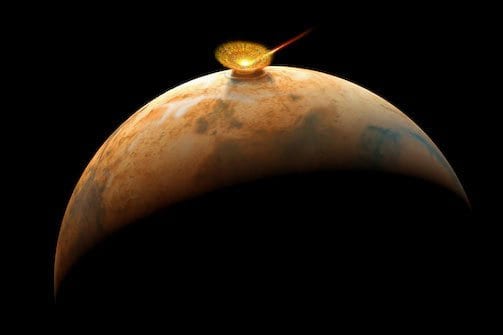Life as we know it is made up of six basic building elements — carbon, hydrogen, nitrogen, oxygen, phosphorus, and sulfur. Without the presence of these, life would have ceased to exist. A long-debated and often-dismissed theory known as “panspermia” came back to life in the past week, as two scientists individually proposed that early Earth might have lacked some chemicals essential to forming life, while early Mars most likely to have had them,
A study from 2016 claims that the Earth’s core does not have evidence of carbon, nitrogen, and sulfur, leading scientists to believe that the elements arrive on Earth from an interstellar body. In the past, researchers have put forth the theory that life could have arrived on a series of meteorite strikes, but this new study suggests it was one, giant collision.

Supporting this is the fact that one of the stumbling blocks to life starting on Earth is the fact that water is almost universally accepted as necessary for the onset of life. Yet RNA—which many consider being the earliest expression of genetic replication and another essential forerunner to life as we know it—falls apart if you try to build it in water. This further propels the Mars theory.
What keeps that from happening, according to Steven Benner who in his years of study has found, is the presence of the element boron. While geologists say boron was too scarce on early Earth to support any widespread creation of RNA, it was seemingly more abundant on early Mars.

Nature Geoscience made a similar argument about phosphorus compounds, which form the backbone of RNA, DNA, and proteins. While phosphates were present on early Earth, as claimed by author Christopher Adcock of the University of Nevada, Las Vegas, they were most frequently found in a solid-state, in which they are most stable. Yet biology is believed to have started in water, which would have contained little of the phosphates on early Earth.
Dasgupta is a deep-rooted supporter of the theory that an ancient impact broke off the chunk of matter that became the Moon and gave Earth the materials that led to life as we know it. But these latest experiments, he believes, are crucial new evidence — and could lead to a new understanding of how life on Earth came to be.

“This study suggests that a rocky, Earth-like planet gets additional probabilities to accumulate life-essential parts if it forms and grows from large impacts with planets that have sampled completely different building blocks, maybe from totally different elements of a protoplanetary disk,” Dasgupta aforesaid.
“This removes some boundary conditions,” he said. “It shows that life-essential volatiles will reach the surface layers of a planet, even though they were created on planetary bodies that underwent core formation under very completely different conditions.”
Dasgupta aforesaid it doesn’t seem that Earth’s bulk silicate, on its own, may have earned the life-essential volatile budgets that created our region, atmosphere, and hydrosphere. “That means that we will broaden our hunt for pathways that result in volatile parts coming back along on a planet to support life as we all know it.”
Further Reading:


